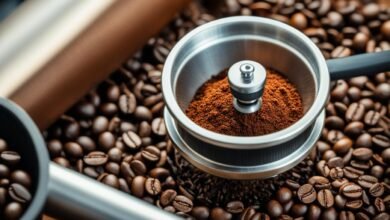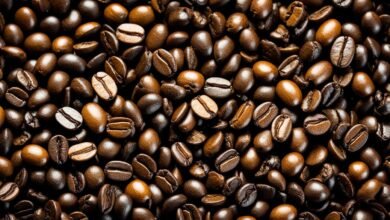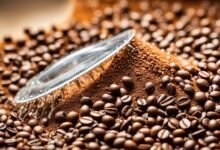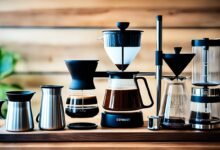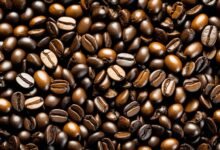Coffee Brewing Temperature Guide
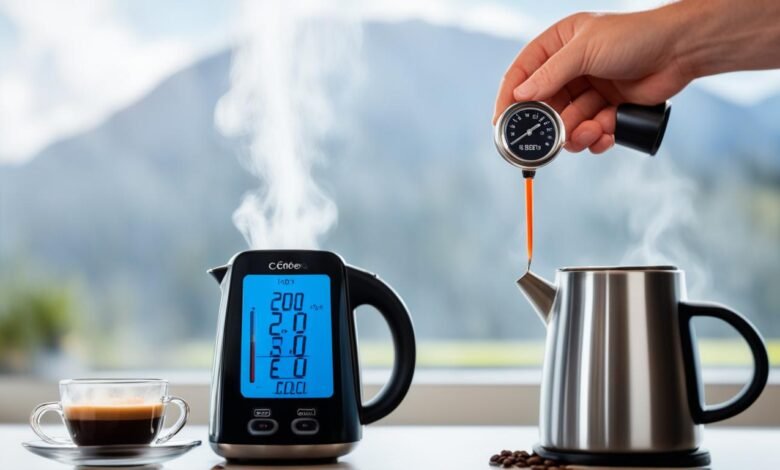
For coffee lovers, the perfect cup starts with the right brewing temperature. This key element greatly affects the rich, balanced flavors we all love. Let’s explore the science behind coffee extraction and find the secret to a great brew every time.
Key Takeaways
- Ideal water temperature for brewing coffee is between 195-205°F (91-96°C) for optimal extraction.
- Temperatures above 205°F can lead to over-extraction, resulting in bitterness and astringency.
- Temperatures below 195°F can cause under-extraction, producing sour, weak, or watery coffee.
- Brewing method, coffee roast level, and bean type all influence the ideal temperature range.
- Precise temperature control is key for consistent, high-quality coffee at home.
Understanding the Importance of Brewing Temperature
The temperature of the water for brewing coffee is key to the taste of your coffee. Hot water pulls out the oils, flavors, and compounds from the coffee grounds. But, water that’s too hot can make the coffee taste bitter. If it’s too cold, the coffee might taste flat or sour.
Why Water Temperature Matters for Coffee Extraction
The best temperature for brewing is between 195°F and 205°F. This range helps get the coffee’s full flavor. Water hotter than 205°F can make the coffee too bitter. And water cooler than 195°F won’t bring out the coffee’s best taste.
The Impact of Too Hot or Too Cold Water
Water that’s too hot can ruin the coffee’s taste, making it bitter. On the other hand, water that’s too cool will make the coffee taste sour and weak. This is because it can’t extract the coffee’s full flavor.
| Water Temperature | Extraction Impact | Flavor Profile |
|---|---|---|
| Over 205°F | Over-extraction | Harsh, Bitter |
| 195°F to 205°F | Balanced Extraction | Optimal Flavor |
| Under 195°F | Under-extraction | Flat, Sour, Watery |
Knowing how water temperature affects coffee is key to making a great cup of coffee.
What is the Ideal Coffee Brewing Temperature?
Temperature is key to brewing the perfect cup of coffee. The Specialty Coffee Association says the ideal water temperature is 200°F (93.33°C). This temperature helps bring out the coffee’s flavors, making a balanced and tasty brew.
The Optimal Temperature Range for Balanced Extraction
Ground coffee works best with water just below boiling. The best brewing methods use temperatures between 195°F and 205°F (90°C to 96°C). This range extracts the coffee’s aromas well, avoiding a bitter taste.
The type of coffee beans and brewing method affect the ideal temperature. Light roast beans need a bit higher temperature, around 206°F to 208°F (96°C to 97.8°C), for the best extraction. Darker roasts do better at lower temperatures to prevent bitterness.
Pour-over and French press coffee should have water between 195°F and 205°F (90°C to 96°C). The AeroPress works well even at 165°F (74°C) thanks to its pressure.
Espresso machines also work best in the 195°F to 205°F (90°C to 96°C) range for a perfect brew. Moka pots use boiling water for a sweet, quick brew.
Let the kettle cool for 30 seconds after boiling to get the right temperature for coffee. Water at 212°F (100°C) is too hot and can ruin the brew.
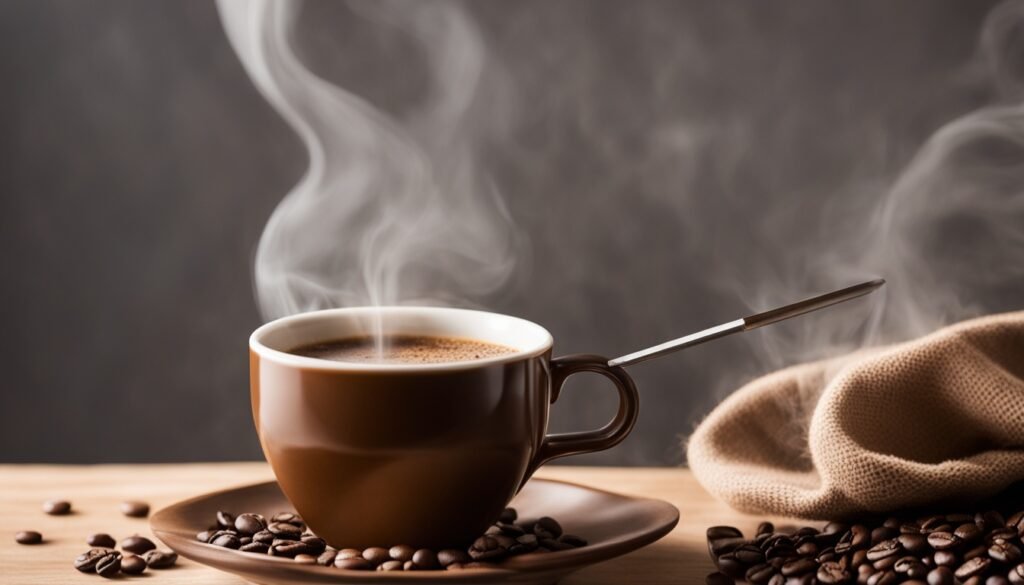
Knowing the best temperature for brewing unlocks the full taste of your favorite coffee. This way, coffee lovers can enjoy a delightful and flavorful cup every time.
Factors Influencing the Ideal Brewing Temperature
The ideal brewing temperature for coffee is usually between 195-205°F (90-96°C). But, different factors can change this for your brewing method and setup. The way you extract the coffee, the container you use, and how well it keeps heat all affect the perfect brewing temperature.
Extraction Method: Pour Over vs. French Press
The brewing method you pick can change the temperature you need. For example, pour over brewing might do better with a bit more heat to make up for the quick heat loss when water meets the coffee grounds. On the other hand, the French press method, which steeps for longer, might work best with a bit less heat to avoid over-extracting the coffee.
Coffee Container and Heat Retention
The kind of coffee container you use affects how well it keeps heat. Insulated vessels are great at keeping the 195-205°F (90-96°C) temperature needed for brewing. They don’t lose heat as much as ceramic mugs or other containers without insulation do during brewing.
| Brewing Method | Ideal Temperature Range | Factors to Consider |
|---|---|---|
| Pour Over | 195-205°F (90-96°C) | Higher temperature to compensate for heat loss |
| French Press | 195-205°F (90-96°C) | Slightly lower temperature to prevent over-extraction |
| Insulated Vessel | 195-205°F (90-96°C) | Maintains ideal temperature throughout brewing |
| Non-Insulated Container | 195-205°F (90-96°C) | Significant heat loss during brewing process |
Knowing what affects the ideal brewing temperature lets you adjust your coffee making for the best flavor every time.
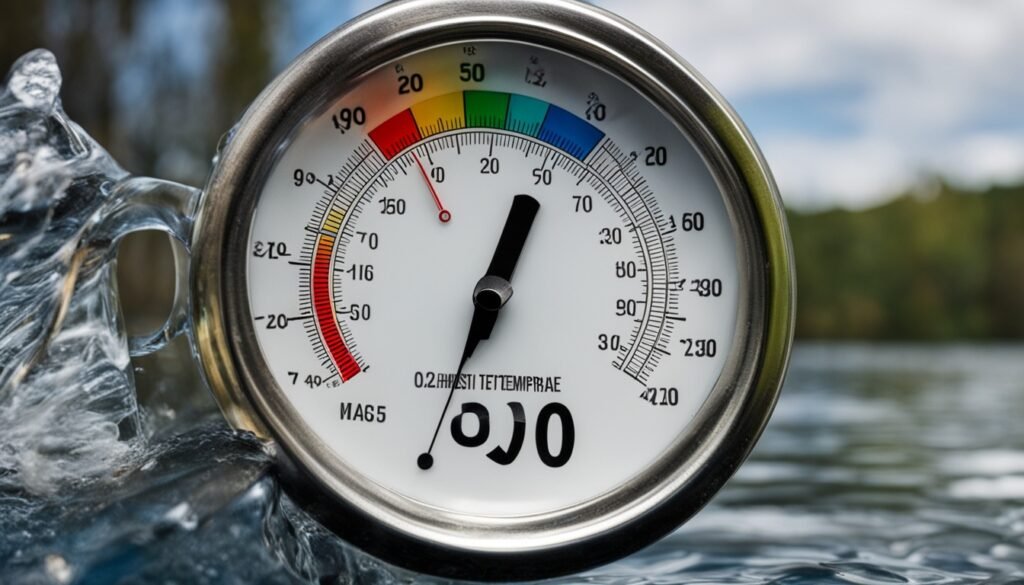
Brewing with Precision: Controlling Temperature Variables
Getting the perfect brewing temperature is key to bringing out the best flavors in your coffee. It’s important to keep the temperature steady for great results. Adding milk or cream changes the temperature, so you need to adjust.
Adjusting for Milk or Cream Addition
Adding milk or cream lowers the coffee’s temperature. To keep the taste right, brew your coffee at a bit higher temperature, between 90°C to 96°C. This helps keep the extraction balanced, even with dairy added.
By controlling the temperature and adjusting for dairy, you can make sure your coffee is just right. This small change can greatly improve the taste and quality of your coffee.
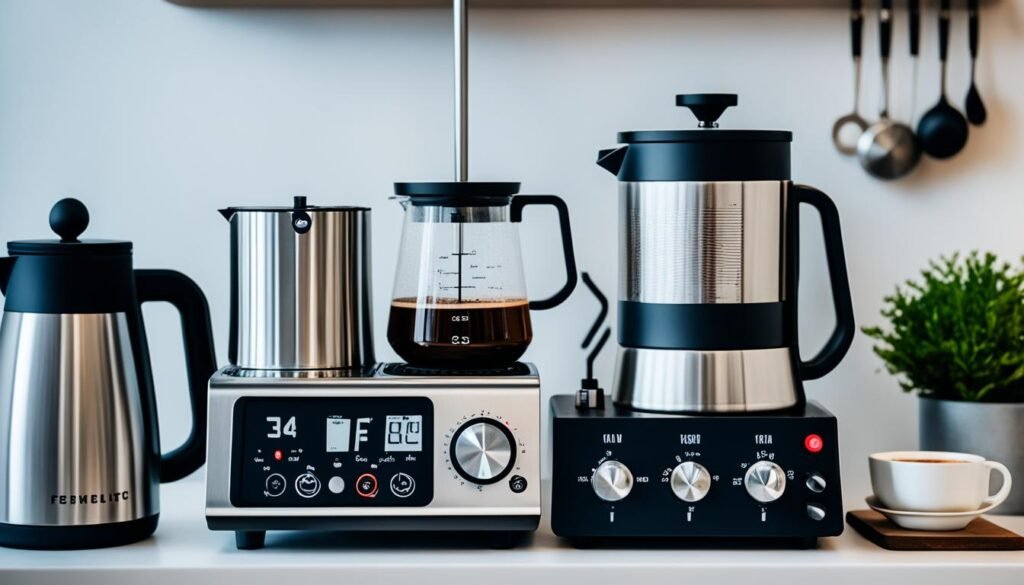
“The focus on total dissolved solids (TDS) and percent extraction (PE) in extraction dynamics appears to overshadow the impact of brew temperature on flavor profile in drip brew methods.”
Experts say brewing temperatures should be between 92-96°C. But, the effect on coffee taste might not be as big as we thought. This is if other factors like extraction are in check.
Knowing how to control temperature and adjust for dairy lets you make coffee with precision. You’ll get a balanced and tasty cup every time, just how you like it.
Coffee, Brewing, Temperature Guide: Essential Considerations
In our Coffee Brewing Temperature Guide, we’ve shown how water temperature is key to bringing out your coffee’s best flavors. We’ve covered the science of optimal extraction and the ideal temperature range. This guide is perfect for both new and experienced home baristas, giving you the skills for a delicious, balanced coffee every time.
The best water temperature for brewing coffee is between 195 to 205 degrees Fahrenheit. This ensures the coffee tastes great without being too bitter. Most people like their coffee around 140 degrees Fahrenheit or less. So, finding the right balance is crucial.
Other important factors like the coffee-to-water ratio and brewing time also matter a lot. The “Golden Ratio” suggests using one to two tablespoons of ground coffee for every six ounces of water. Also, brewing times vary: about 5 minutes for drip systems, 2-4 minutes for French Press, 20-30 seconds for espresso, and 12 hours for cold brew.
| Brewing Method | Ideal Temperature Range | Recommended Brewing Time |
|---|---|---|
| Drip Coffee | 195°F – 205°F (90°C – 96°C) | 5 minutes |
| French Press | 195°F – 205°F (90°C – 96°C) | 2-4 minutes |
| Espresso | 195°F – 205°F (90°C – 96°C) | 20-30 seconds |
| Cold Brew | Room temperature or refrigerated | 12-24 hours |
By knowing and using these tips, you can make a delicious, balanced coffee every time. This unlocks the full taste of your favorite beans and brewing methods.
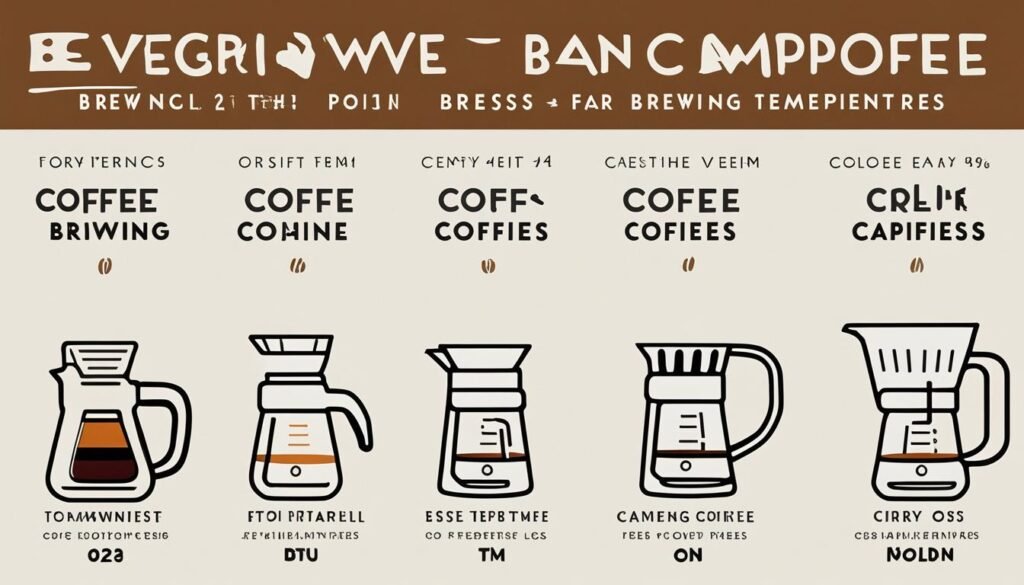
Bean Type and Roast Level Matter
When brewing the perfect cup of coffee, the type of bean and its roast level matter a lot. Arabica beans, being delicate and complex, do best with a brewing temperature of 195°F to 200°F. Robusta beans, on the other hand, are stronger and more caffeinated. They can be brewed at a higher temperature, between 195°F and 205°F, without over-extracting.
Darker roasts, roasted for longer, extract flavors easily and might need lower brewing temperatures. This is because their increased porosity makes extraction efficient even at lower temperatures.
| Roast Level | Ideal Brewing Temperature | Extraction Ratio | Brew Time |
|---|---|---|---|
| Light Roast | 195°F – 200°F | 1:2 (coffee to water) | 28-30 seconds |
| Medium Roast | 200°F | 1:1.5 (coffee to water) | Around 22 seconds |
| Dark Roast | 195°F | 1:1 (coffee to water) | Around 22 seconds |
Understanding how bean type, roast level, and coffee extraction work together lets you improve your brewing. This way, you can bring out the best flavors in your coffee.
“The art of brewing coffee is not just about the temperature, but also the delicate balance between the bean type, roast level, and extraction process.”
Experimenting to Find Your Perfect Cup
Finding the perfect cup of coffee is a journey of trial and error. The ideal brewing temperature changes with your taste and the coffee beans you use. By experimenting with different brew times and coffee-to-water ratios, we can improve the extraction process. This helps us find the temperature that brings out the best flavor in our favorite beans. Don’t hesitate to adjust and keep track of your changes to slowly find your perfect cup.
Trial and Error: Adjusting Brew Time and Ratio
Begin by brewing your coffee at a temperature between 195-205°F (90-96°C). Then, play with the brew time and brew ratio (the coffee grounds to water amount) to see how it changes the taste. A longer brew time or more coffee grounds makes a stronger brew. A shorter time or less grounds gives you a lighter cup.
- Try different brew times, starting with the usual 4-6 minutes for drip coffee and adjust by 30 seconds at a time.
- Change the brew ratio, beginning with a 1:16 coffee-to-water ratio (15g of coffee per 240ml of water) and try other ratios like 1:14 or 1:18.
- Keep a record of your experiments, noting the temperature, time, and ratio, and the flavor you get.
By tracking your experiments, you’ll find the right mix of temperature, time, and ratio for your perfect cup of coffee. Remember, the key is to experiment and enjoy the process.
Coffee Brewing Equipment for Precise Temperature Control
For those who love precise control over their coffee’s temperature, high-quality brewing equipment is key. Brands like Breville offer top-notch coffee makers and espresso machines. They have features like the Thermacoil heating system with PID control. These let you set the brew temperature, flow rate, and contact time. This way, you can bring out the best flavor from your coffee beans.
The perfect temperature for pour-over and drip coffee is between 195°F and 205°F (90°C to 96°C). Espresso machines work best at around 199°F (93°C) for great extraction. Getting the temperature right is key for a great taste, aroma, and satisfaction.
For the best temperature control, think about getting a temperature-controlled kettle or a coffee maker with advanced heating. These tools help keep your brew at the perfect temperature. This lets you really enjoy the unique tastes of your favorite coffee beans and roasts.
| Brewing Method | Ideal Temperature |
|---|---|
| Pour-Over | 205°F (96°C) |
| Drip Coffee | 195-205°F (90-96°C) |
| Espresso | 199°F (93°C) |
| French Press | 194°F (90°C) |
With the right coffee brewing equipment and precise temperature control, you can really bring out the best in your coffee. Enjoy a consistently great cup every time.
The Art of Brewing: Mastering the Fundamentals
Brewing the perfect cup of coffee is both an art and a science. It’s important to know the best brewing temperature. Also, you must master the fundamentals of making coffee for flavorful results. This means cleaning your coffee gear, like grinders and filters, after each use.
Cleaning removes coffee grounds and oil residue. This keeps your equipment in good shape and stops bad flavors from getting into your coffee.
Clean Equipment for Consistent Flavor
Having clean equipment is key for a flavorful cup of coffee. Here are some tips to keep your gear clean:
- Regularly clean your grinder with a brush or cleaner to get rid of grounds.
- Soak filters, carafes, and parts you can take out in hot, soapy water or a coffee cleaner to remove oils and flavors.
- Descale your coffee maker or kettle to stop mineral buildup, which can change water temperature and flow.
- Wipe down your equipment with a damp cloth to keep it looking clean.
Spending time on cleaning your equipment keeps your coffee-making process consistent. It also keeps it free from bad flavors or impurities.
“Brewing great coffee is a blend of science and art. Mastering the fundamentals, like maintaining clean equipment, is key to unlocking the full potential of your beans.”
Conclusion: Unlocking Coffee’s Flavor Potential
Understanding how to control the water temperature is key to getting the most out of our coffee. We’ve learned the best temperature range and how different factors affect it. With this knowledge, we can make a delicious, balanced, and flavorful cup of coffee every time.
If you’re new to making coffee at home or you’ve been doing it for years, these tips will take your coffee to the next level. We’ve covered how to keep your coffee at the right temperature and how to adjust brewing based on the coffee’s roast. This guide will help you discover new flavors in every cup.
Using temperature to improve our coffee brewing makes every sip enjoyable and fulfilling. As we get better at making coffee and try new methods, we’ll appreciate the art more. We’ll see how temperature changes the taste of our coffee.
